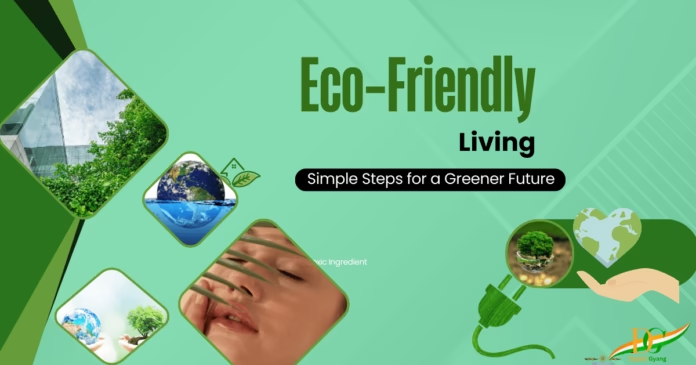
Discover how to embrace eco-friendly living with practical tips on sustainability, reducing waste, and making environmentally responsible choices. Start your journey towards a greener future today!

Introduction
Eco-friendly living is more than just a passing trend— Such practices should be considered essential for our contemporary society. Human operations produce severe environmental consequences which include mounting global warming effects together with environmental pollution and diminishing natural resources.
The existing environmental problems will escalate if humans fail to take quick and effective sustainability measures which endanger every living organism.People who practice environmentally friendly living habits create substantial reductions in the environmental effects on our world. Daily life alterations aimed at waste reduction combined with energy conservation together with sustainable decision-making generate aggregated positive results for environmental health. Through eco-friendly living practices individuals benefit their personal health through pollution reduction along with attaining a sustainable way of life. Eco-friendly living heavily depends on people developing awareness about their environmental impact.
People gain knowledge about their environmental impact through daily routines. Because of this knowledge they develop better decisions about actions that affect the planet. The combination of economical appliances with moral brand support enables significant environmental change through minor behavioral adjustments. Active sustainability practice enables human beings to protect their ecosystems and lower their resource usage to reduce their environmental impact.
The following guide presents specific steps for adopting greener life practices. The guidelines presented in this text will support anyone at any level of sustainability experience to transition toward environmentally conscious living. People who embrace eco-friendly living develop a better future both personally and for future generations.
Why Eco-Friendly Living Matters
The environment is under severe strain due to human activities. Deforestation, excessive plastic waste, and high carbon emissions have led to significant damage. These environmental challenges not only harm ecosystems but also impact human health and future generations.Ecologically sustainable residences achieve pollution reduction as their main environmental advantage. Through sustainable practices as well as productive waste management and environmentally friendly product selection we can achieve lower pollution rates in water systems and air spaces and on the ground. Natural resource conservation of water and forests along with minerals creates sustainability for the future needs of humanity.
Wildlife along with biodiversity stands as an essential focus point. Many species face extinction due to habitat destruction and pollution. Human decisions toward supporting conservation while minimizing plastic consumption lead to preservation of Earth’s precious environmental equilibrium.Practices designed for environmental sustainability along with their related health benefits create a better quality of life. People experience better wellbeing through limited toxin exposure from processed foods as well as chemicals and airborne contaminants. Sustainability brings health benefits through walking, cycling and adopting plant-based diets which improve both health status and physical fitness.
By embracing eco-friendly living, we contribute to a cleaner, more sustainable world. Every small step taken toward sustainability helps create a positive impact, ensuring a greener and healthier future for all.
The environment faces serious stresses because of what people do. Three major environmental issues exist because humans continue to destroy forests and produce excessive plastic waste while emitting high amounts of carbon pollution. Eco-friendly living choices provide us with the possibility to protect the environment.
- Reduce pollution and waste
- Conserve natural resources
- Protect wildlife and biodiversity
- Improve overall health and well-being
Cold Girl Makeup Look – Achieve the Ultimate Frosty Glow
1.Sustainable Home Practices
To achieve sustainable living in the home space one must perform decisions which lower environmental impact alongside preserving energy supplies and protecting the planet. A sustainable home can reduce its carbon impact through in standby mode. Simple energy efficiency measures that include moving to LED illumination alongside natural window ventilation and solar power generation prove essential for lowering power intake. The conservation of water becomes possible when household facilities have leak repairs as well as when homeowners utilize rainwater for landscaping. The practice of composting and recycling waste promotes zero waste living throughout households. The implementation of these practices allows people to build environmentally friendly living spaces which provide advantages to planet conservation and next-generation success.
Reduce Energy Consumption
- Switch to LED bulbs: They last longer and use less energy.
- Unplug devices: Electronics consume power even when turned off.
- Invest in energy-efficient appliances: Look for ENERGY STAR-rated products.
- Use natural light: Open curtains during the day to minimize electricity use.
Water Conservation Tips
- Fix leaks: A dripping tap wastes gallons of water daily.
- Install low-flow fixtures: Reduce water usage in showers and faucets.
- Collect rainwater: Use it for gardening and cleaning.
- Turn off taps: Don’t let water run while brushing your teeth.
2. Eco-Friendly Shopping Habits
People who practice eco-friendly shopping maintain careful decision-making for sustaining both sustainability and minimizing waste. People who reduce environmental impact should select items that either have ethical sourcing standards or are reusable or designed to decompose naturally. The practice of buying from local producers benefits independent businesses and it helps decrease emissions through transportation sector.
People who carry reusable bags and containers together with reusable bottles help decrease environmental pollution because they do not use plastic supplies once. People who wish to shop for garments should choose both responsible fashion items and used items to lower textile waste while supporting fair manufacturing processes. Sustainable consumer habits empower people to fight waste while implementing positive changes that push companies toward environment-friendly operations.
Choose Sustainable Products
- Buy organic and locally sourced produce.
- Opt for products made from recycled or biodegradable materials.
- Use reusable bags, bottles, and containers.
- Avoid single-use plastics.
Ethical Fashion Choices
- Support sustainable clothing brands.
- Buy second-hand or upcycled fashion.
- Donate or repurpose old clothes instead of discarding them.
3. Waste Reduction Strategies
Strategies to reduce waste aim to produce less waste while promoting material reuse together with safe disposal techniques to stop environmental spread of pollutants. The three principles of Reduce Reuse Recycle actively help decrease additional waste in landfills while preserving resources. The reduction of consumption paired with avoidance of unnecessary packaging and selection of durable items helps decrease production of waste. The repurposing of glass jars together with old clothing extends their existence while decreasing the market demand for fresh products. People who recycle materials including plastics and metals together with paper prevent their total disposal in landfills. The practice of composing organic waste materials leads to both environmental advantages and ecological benefits while supporting a zero-waste existence.
The 3 R’s: Reduce, Reuse, Recycle
- Reduce: Minimize packaging waste and unnecessary purchases.
- Reuse: Repurpose items like glass jars and old fabrics.
- Recycle: Properly separate plastics, paper, and metals for recycling programs.
Composting for a Zero-Waste Home
- Compost food scraps to enrich soil and reduce landfill waste.
- Use compost bins for organic waste like fruit peels, coffee grounds, and eggshells.
4. Green Transportation Options
The strategy of green transportation selects sustainable travel approaches as a method to diminish carbon pollution. Traveling by foot or bicycle remains an excellent method to cover short distances because it produces environmental advantages and enhances personal well-being. The reduction of road traffic happens when people use public transportation and carpooling and ride-sharing services thus lowering pollution levels.
Those making lengthy travel journeys should consider hybrid or electrical vehicles which provide environmentally responsible transportation instead of standard fuel-powered cars. Remote work and telecommuting enable people to reduce their need for daily trips between home and office and this reduces environmental emissions. Flighting sustainable transportation represents an efficient method for people to diminish their carbon impact while making the atmosphere more wholesome.
- Walk or bike instead of driving for short distances.
- Use public transport or carpool to reduce emissions.
- Consider electric or hybrid vehicles for a sustainable commute.
5. Eco-Friendly Food Choices
Mindful eating habits serve as the main principle of making environmentally friendly food choices to minimize environmental effects. The lifestyle switch toward plant-based meals results in major reductions of greenhouse gas emissions because meat production outlets many harmful gases into the atmosphere. The choices to support farmers at local markets help decrease transportation pollution while helping farmers practice sustainable farming methods. One can save resources by planning meals in advance and storing food properly while composting food wastes into soil. Healthcare along with environmental wellness would benefit from selecting organic seasonal produce because it results in reduced harmful pesticide usage during cultivation. Selecting food with intention allows people to develop an eco-friendly food supply that benefits the environment.
- Eat more plant-based meals to lower carbon emissions.
- Support local farmers and markets to cut transportation pollution.
- Reduce food waste by planning meals and storing food properly.
6. Sustainable Work and Office Practices
Different office practices alongside work habits contribute to decreased environmental impact at professional workplaces. Businesses minimize deforestation together with waste through the adoption of digital documentation systems. Using LED bulbs in place of other lighting types decreases electricity usage because they use more efficient energy. Organizations should support employees working from home because it lessens the emissions caused by commuting.
The use of sustainable lunch packaging as well as reusable coffee containers together with environmentally friendly office materials contributes to sustainability objectives. The workplace sustainability improves through office waste recycling along with lowering energy usage through device power management and selecting environmentally certified products. Various environmentally friendly practices implemented by offices and businesses enable substantial carbon emission reductions as they build sustainable workplaces.
- Go paperless by using digital documents.
- Use energy-efficient lighting in offices.
- Bring reusable lunch containers and coffee cups.
Top Indian Dating Sites for Professionals—
7. Creating an Eco-Conscious Community
- Educate others about sustainability.
- Participate in clean-up drives and tree-planting events.
- Support eco-friendly businesses and initiatives.
Conclusion
Being eco-friendly represents a duty that exists for all humans to safeguard our planet. Everyone can help reach the sustainability goal by performing any small action. Implementing sustainable behaviors in our daily routines enables us to strengthen our existing environment and establish enduring effects that will benefit the next generation.
Living in a sustainable way demands commitment together with devoted action from people. Making progress towards sustainability requires breaking big actions into small steps since many individual changes merged together produce significant benefits. You can begin your sustainability journey by targeting little yet obtainable sustainable goals that include plastic minimization throughout your day and cycling rather than driving and backing local businesses. Then you can progressively extend your sustainability programs.
The benefits of eco-friendly living go beyond environmental protection. The lifestyle comes with advantages that maintain health and reduce expenses and creates social connections. Making sustainable decisions creates benefits that result in nutritious diets and filtered air and decreased contact with dangerous substances. The adoption of eco-friendly practices leads to reduced household costs because it decreases both energy and water consumption thus demonstrating the practical benefits of such lifestyles.
People hold the ability to steer business operations and public sector actions as well as industrial direction by backing new environmental protection standards and endorsing environmentally conscientious projects. Massive meaningful change becomes possible through joint efforts by people. The path toward eco-friendly living continues forever since its benefits remain precious to everyone involved in this movement. Today’s conscious decisions will create a sustainable future which benefits the entire population.
You Like this Article- Visit our website Here
Frequently Asked Question (FAQs)
1.What is eco-friendly living?
Eco-friendly living refers to making conscious lifestyle choices that minimize harm to the environment, such as reducing waste, conserving resources, and using sustainable products.
2.Why is eco-friendly living important?
The implementation of nature preservation methods produces multiple health-related benefits for the environment and human wellness and the planet remains healthier because of it.
3.How can I start living an eco-friendly lifestyle?
Begin environmental sustainability by adopting small changes between reusable shopping bags alongside water conservation and energy reduction as well as recycling waste resources.
4.What are some eco-friendly alternatives to common household items?
Bamboo toothbrushes serve as an alternative to both plastic toothbrushes and LEDs are preferable over traditional lighting solutions.
5.How can I reduce my carbon footprint at home?
The reduction of energy consumption occurs through renewable energy adoption together with unplugging devices after use alongside public transport and bicycle choices instead of vehicle ownership.
6.Is eating plant-based food better for the environment?
Yes,Plants used for diets result in lower greenhouse gas emissions along with water preservation and require less land than the production of meat as diets.
7.How does reducing plastic waste help the environment?
A reduction in plastic waste helps decrease polluting agents that become trapped in water bodies and landfill sites therefore safeguarding ecosystems and minimizing plastic pollution effects over time.
8.What are some sustainable fashion choices?
Second-hand clothing purchases along with brand selection that uses organic or recycled materials should become your practice since fast fashion leads to environmental destruction.
9.How can businesses adopt eco-friendly practices?
Businesses that want to conserve resources should limit their printing practices while selecting sustainable kitchen equipment along with waste reduction measures and developing environmentally friendly supply chain management protocols.
10.What are some ways to educate others about eco-friendly living?
Your social media platform serves as a platform to spread environmental knowledge and you should join local environmental activities while motivating those in your network to practice sustainable choices.



